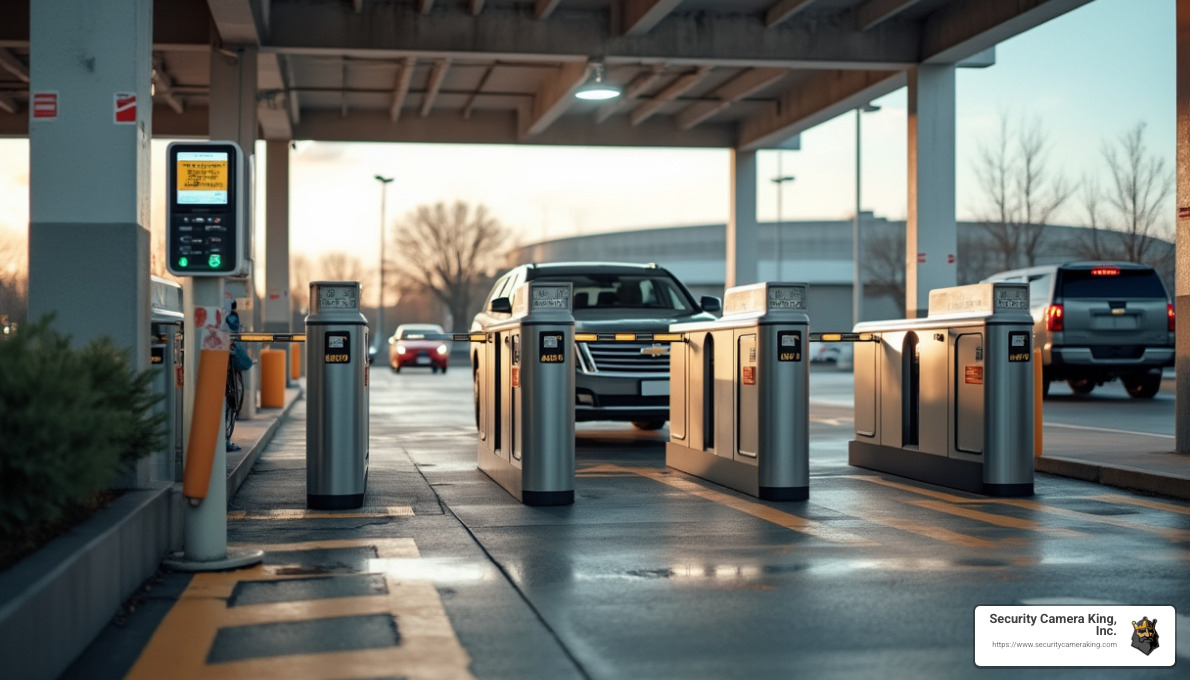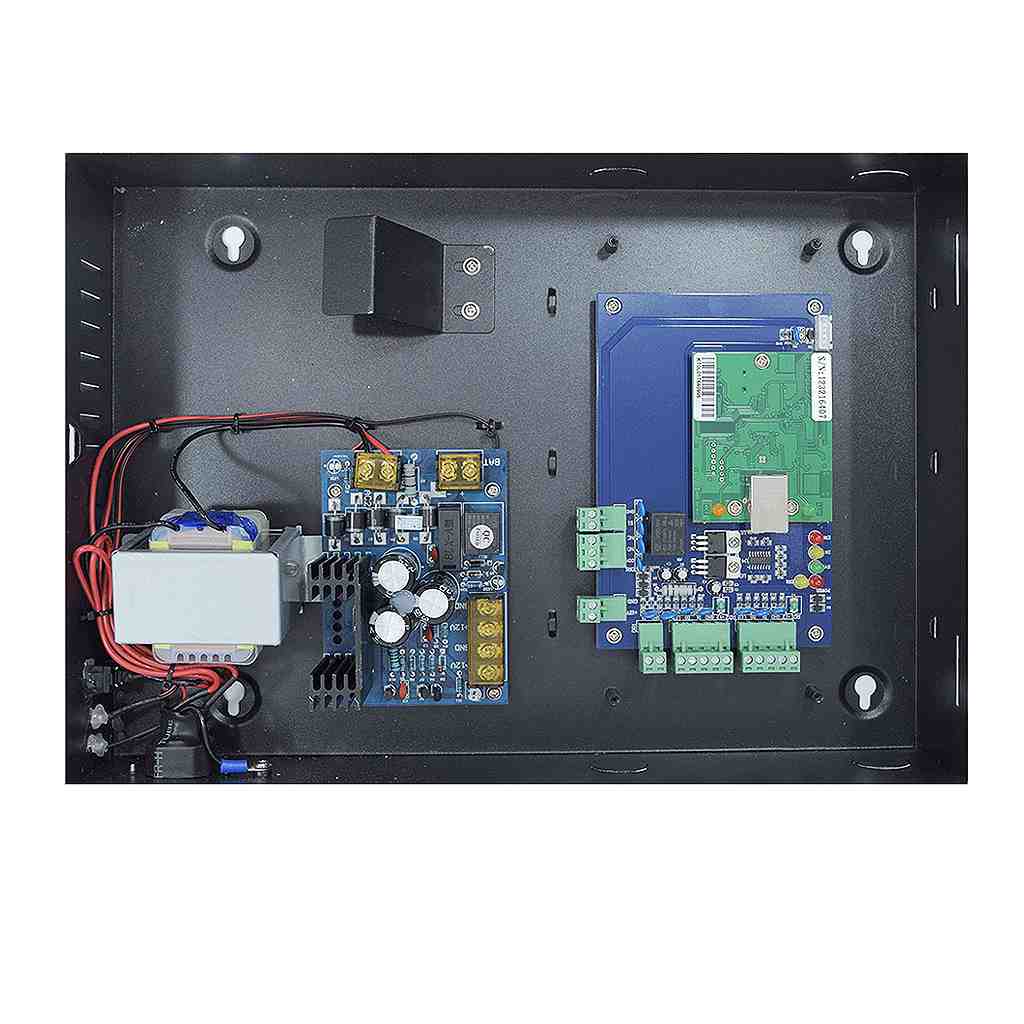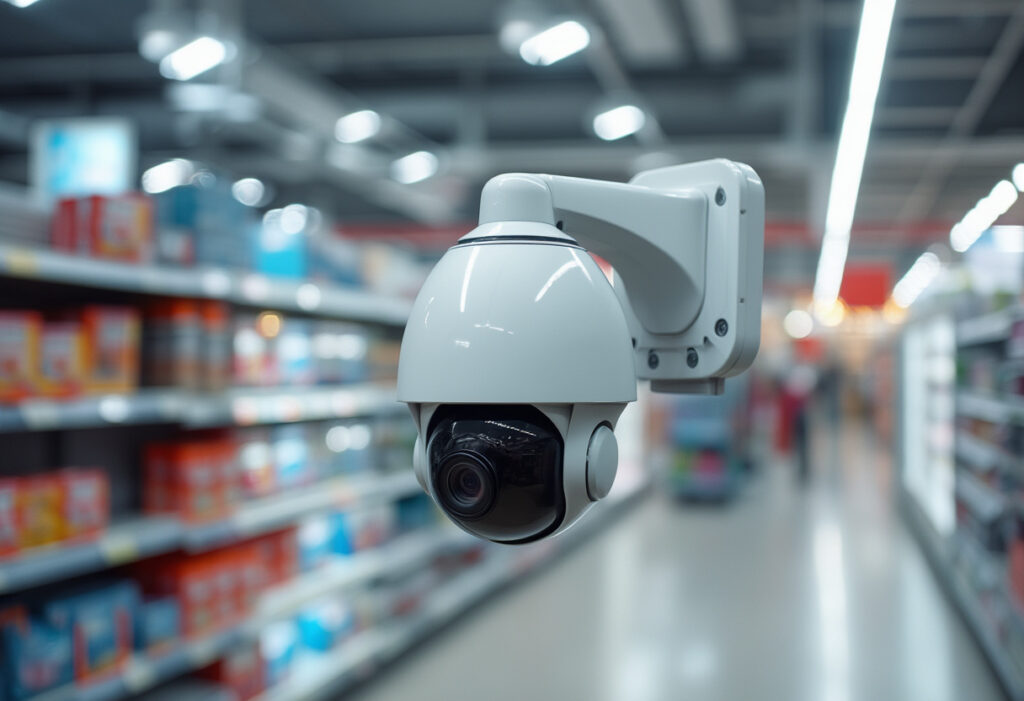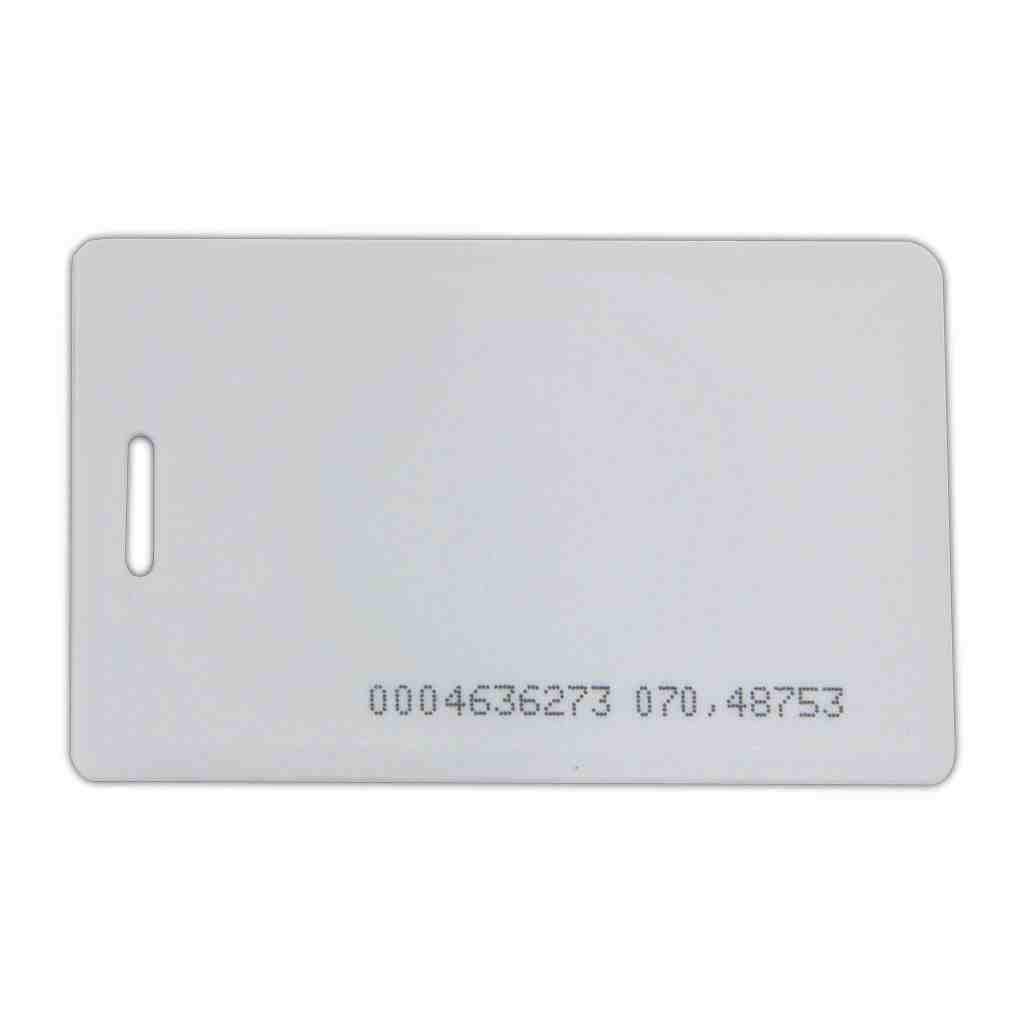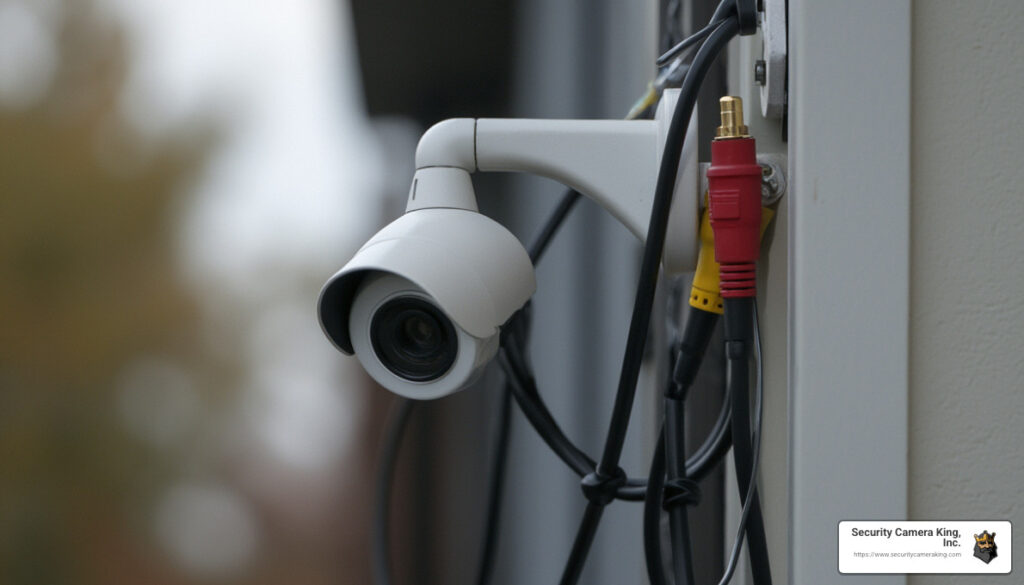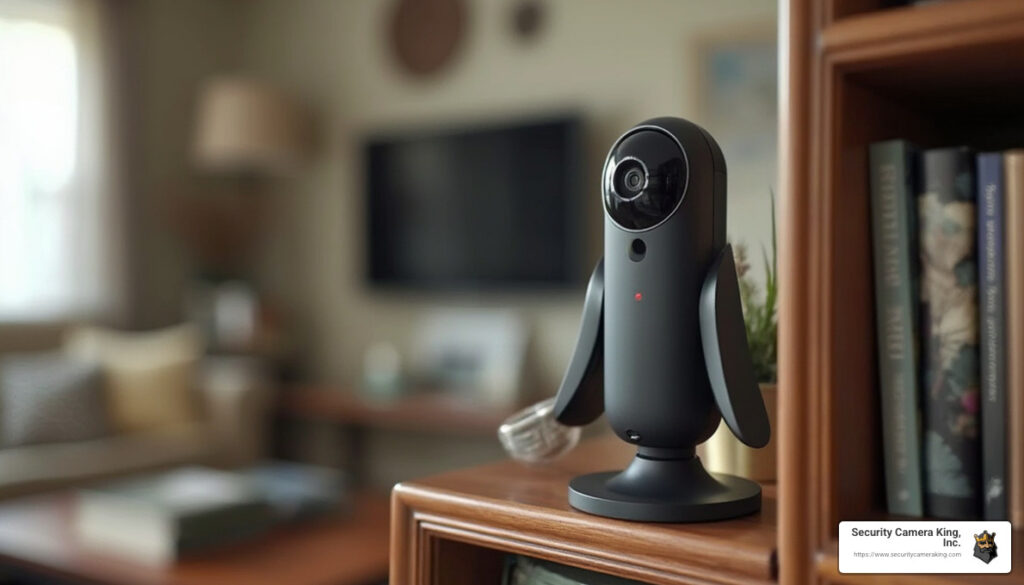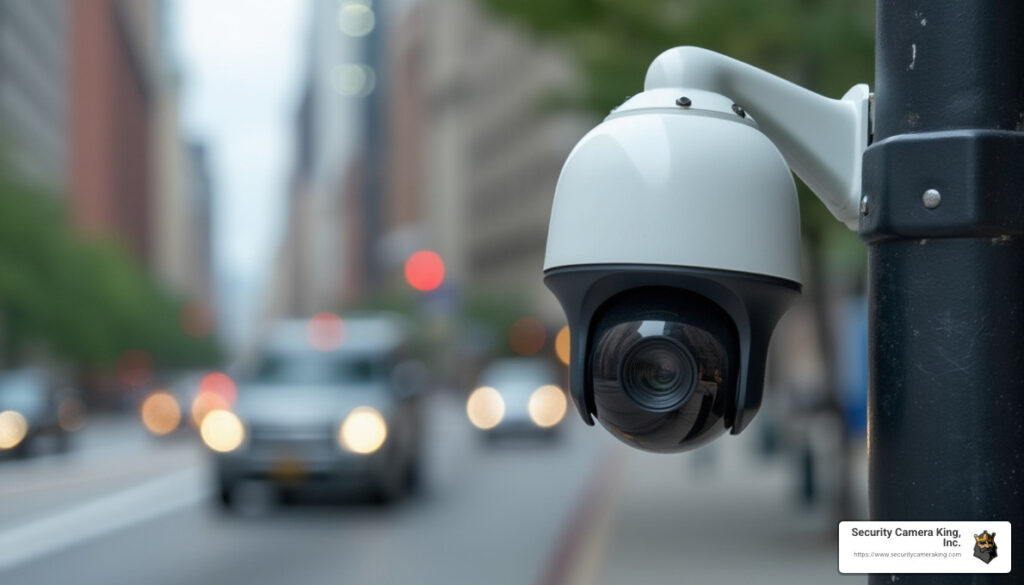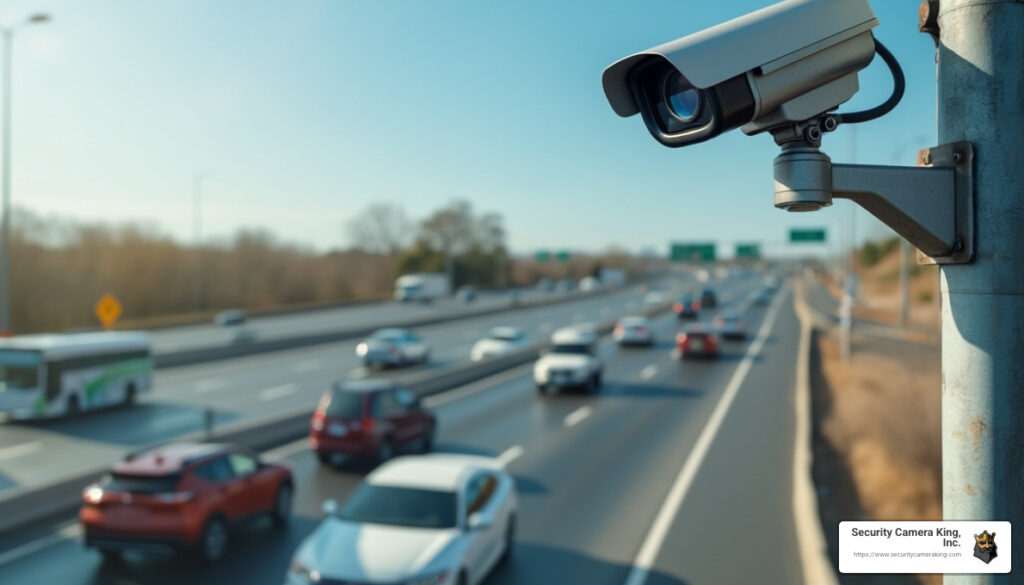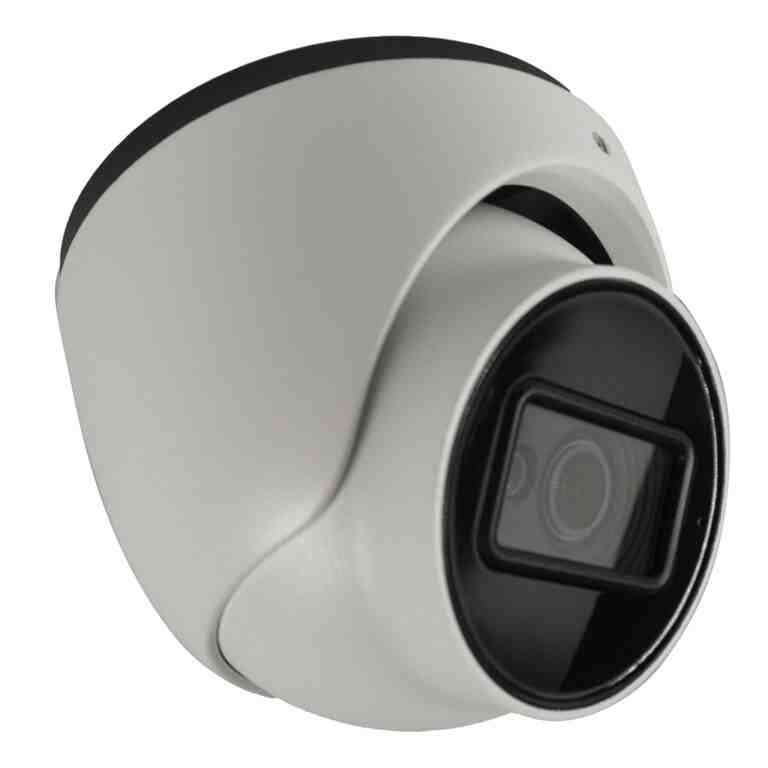Access Control Parking Systems: 7 Powerful Benefits in 2025
The Evolution of Modern Parking Security
Access control parking systems have transformed how we think about parking security and management. At their core, these systems are automated solutions that do the important work of controlling who enters and exits your parking facilities, all while gathering useful data and potentially creating revenue streams for your business.
Think of these systems as the perfect blend of hardware and software working together to create a seamless experience for both you as the operator and for the people using your parking facility.
| What Are Access Control Parking Systems? | How They Work | Key Benefits |
|---|---|---|
| Automated security solutions that control vehicle access to parking facilities | Verify credentials via RFID, license plate recognition, or mobile apps before opening barriers | Improve security, generate revenue, provide usage analytics |
| Combine physical barriers with electronic identification | Create audit trails of all entries and exits | Reduce operational costs through automation |
| Range from simple barrier gates to sophisticated integrated systems | Can be integrated with payment processing | Improve traffic flow and user experience |
Here’s something that might surprise you: nearly 880,595 vehicle thefts happen every year in the United States, with parking lots being common targets. This eye-opening statistic shows why having proper access control parking systems isn’t just nice to have—it’s essential for any retail facility today.
Modern systems go well beyond basic security functions. They make your operations smoother by providing accurate data for your accounting team, letting you monitor activity in real-time, and creating better traffic flow that keeps everyone moving efficiently.
The best parking access control solution strikes that perfect balance between tight security and user convenience. While sturdy barriers keep unauthorized vehicles out, technologies like long-range RFID readers can automatically detect credentials from 10-25 feet away, ensuring your authorized users don’t get stuck waiting unnecessarily.
For retail environments specifically, these systems offer some compelling advantages. They prevent theft through controlled access points and integration with video surveillance. They improve customer experience by speeding up entry and exit times and reducing traffic jams. They help with employee management through customized access permissions. And perhaps most importantly for your bottom line, they protect revenue with accurate transaction recording and auditing capabilities.
Hi there—I’m Brad Besner, founder of Security Camera King, Inc. With over a decade of experience helping retail facilities implement access control parking systems, I’ve seen how the right solution can transform a parking facility from a potential security weakness into a valuable business asset. Our team specializes in creating integrated security solutions that not only protect what matters most but also improve your day-to-day operations.

What Are Access Control Parking Systems?
Have you ever wondered what keeps unauthorized vehicles out of private parking lots? Access control parking systems are the unsung heroes of modern parking management. These smart solutions combine physical barriers with electronic identification technology to create secure, efficient vehicle flow while gathering valuable data along the way.
Access Control Parking Systems in a Nutshell
At their heart, access control parking systems work on a simple principle: verify who’s allowed in before opening the gates. When a car pulls up to an entry point, a well-choreographed technological dance begins:
First, sensors embedded in the pavement (those black loops you’ve driven over) detect your vehicle’s presence. Then, the system checks your credentials—maybe it’s scanning your license plate, reading an RFID tag on your windshield, or waiting for you to tap your phone or insert a ticket. Once it confirms you’re authorized, the barrier arm smoothly rises, welcoming you in. Meanwhile, behind the scenes, your entry gets logged into a database, creating a digital record of your visit.
“Parking control is really about ensuring only the right people get access at the right times,” as our team often explains to new customers. This simple concept has evolved into sophisticated systems that do far more than just controlling who enters.
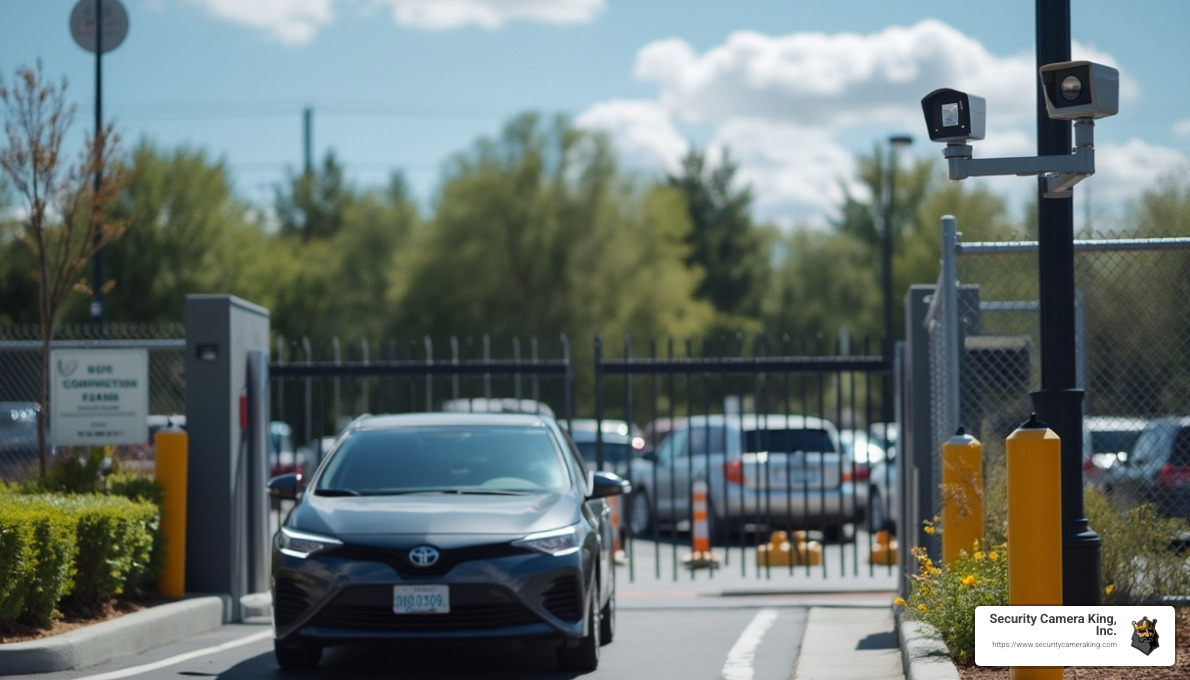
Every time a vehicle enters or exits, access control parking systems create a digital footprint—time, date, credential used, maybe even a snapshot of the vehicle. This audit trail becomes incredibly valuable for security investigations, checking if the revenue numbers add up at the end of the day, understanding traffic patterns, and finding ways to make your parking operation run more smoothly.
Why Modern Facilities Need Them
If you’re wondering whether your facility really needs an access control system, consider these compelling benefits:
1. Improved Security
With nearly 881,000 vehicle thefts happening annually in the US (many in parking facilities), security isn’t optional anymore. Access control parking systems create a robust defense:
Physical barriers keep unwanted vehicles out, while cameras capture license plates and vehicle images for identification. Every entry and exit gets logged, creating accountability. And if something suspicious happens, real-time monitoring allows for immediate response.
2. Revenue Protection and Generation
For commercial parking operations, these systems are financial guardians:
Automated payment processing eliminates the “human error” excuse when numbers don’t add up. Digital records make it nearly impossible for revenue to mysteriously disappear. Time-stamped entries and exits ensure customers are billed accurately for their actual parking duration. And if you run a mixed-use facility, integrated validation systems make it easy to offer parking perks to shoppers or tenants.
As we often tell our retail clients, “If you can’t measure it, you can’t manage it.” Access control parking systems provide crystal-clear data for accounting and auditing, with cloud access to see your revenue figures in real-time, from anywhere.
3. Operational Intelligence
Perhaps the most underrated benefit is the wealth of data these systems generate:
You’ll see exactly when your busy periods happen, how long people typically stay, which areas fill up first, and even patterns in user behavior. This treasure trove of information lets you make smarter decisions about staffing, pricing strategies, maintenance scheduling, and whether that expansion you’re considering is really necessary.
4. User Experience Improvement
Today’s customers expect convenience, and access control parking systems deliver:
They speed up entry and exit times with quick automated verification. This reduces those frustrating lines during peak hours. Modern systems offer multiple payment options—credit card, mobile, contactless—to suit everyone’s preference. Some even allow for reserved parking spaces and display clear guidance on where available spots can be found.
As our cities grow more congested and property values climb, efficient parking management becomes increasingly essential. Access control parking systems transform what used to be a necessary headache into a smooth experience that makes both operators and users happier.
At Security Camera King, we’ve helped countless businesses transition from outdated manual systems to modern, automated parking solutions that protect their property while enhancing the customer experience.
Key Technologies & Components
Modern access control parking systems rely on a variety of technologies working in concert. Understanding these components is essential for selecting the right solution for your facility.

Core Components of Access Control Parking Systems
When you pull up to a modern parking facility, you’re interacting with a sophisticated ecosystem of technologies designed to make your experience smooth while keeping the facility secure. Let’s take a behind-the-scenes look at what makes these systems tick.
The most visible part of any access control parking system is the physical barrier – typically those familiar barrier arms that lift to welcome you in. These barriers aren’t just for show; they serve as both actual obstacles and psychological deterrents. For higher security needs, some facilities combine these arms with more robust solutions like retractable bollards, one-way traffic spikes, or even full barriers for maximum protection.
But the real magic happens with the detection and identification technologies. Think of these as the system’s eyes and ears. Embedded in the pavement, loop detectors sense when your vehicle is present. Meanwhile, various readers work to verify who you are – from RFID readers that wirelessly detect tags on your vehicle to cameras that can recognize your license plate in a split second. Some systems use more traditional methods like barcode scanners for tickets, proximity card readers, or simple keypads. And of course, for those inevitable questions or issues, intercom systems provide that human connection when needed.
Behind all this visible technology sits the control system – the brain of the operation. Access control panels make the crucial decisions about who gets in and who doesn’t, while specialized gate controllers handle the physical movement of barriers. These components talk to each other through network infrastructure, all powered by reliable systems with backups to ensure things keep running smoothly even during power outages.
The software platforms tie everything together, creating an interface where human operators can manage the entire system. These platforms handle everything from basic configuration to complex user permissions, detailed reporting, and financial transactions. The best systems transform raw data into actionable insights, helping facility managers make smart decisions about their operations.
At Security Camera King, our Access Control Panels provide the intelligence needed for seamless parking management, while our One Parking Management Module License for DSS Express V8 offers powerful software capabilities to bring it all together.
Finally, user interfaces create those critical touchpoints where people interact with the system. These might include entry and exit stations, standalone payment kiosks, in-lane payment terminals, mobile apps, or web portals for account management and reservations. The best systems make these interactions intuitive and stress-free.
Access Control Parking Systems Technology Comparison
Not all access control parking systems are created equal. Each identification technology brings its own strengths and limitations to the table.
RFID technology, which uses radio waves to detect and read tags attached to vehicles, offers lightning-fast processing – we’re talking milliseconds here. It works in all weather conditions with nearly perfect accuracy and can read tags from impressive distances. The downside? You’ll need to distribute and manage physical tags, and while today’s encryption is robust, there’s always the theoretical risk of cloning.
License Plate Recognition (LPR) eliminates the need for physical credentials by using cameras to identify vehicles by their plates. It’s perfect for both regular and occasional users, and creates a helpful visual record of each vehicle. Modern AI has made these systems impressively accurate, though they can still struggle in extreme weather or with dirty plates.
For facilities with lots of visitors, QR and barcode systems offer an affordable, familiar option. They’re easy to distribute electronically and integrate beautifully with mobile apps. However, they do require users to position their code properly, and physical tickets can be damaged or lost.
Keypad entry systems keep things simple with no physical credentials to manage. They’re affordable and easy to understand, but they slow down the entry process and lack the detailed tracking capabilities of other options. Plus, there’s always the risk of someone sharing their code or watching over a shoulder as it’s entered.
Mobile phone access represents the cutting edge, leveraging devices people already carry. These systems enable advanced features like reservations and instant communication with users. The main challenges? They depend on phone batteries and connectivity, and may present a learning curve for some users.
In the real world, many of our clients find that a hybrid approach works best. Monthly parkers might zip through with RFID tags while occasional visitors use LPR or scan QR codes. As one of our parking technology experts often says, “The most effective systems layer multiple technologies to create the perfect balance of security, convenience, and efficiency.”
By understanding these core technologies and their trade-offs, you can make informed decisions about which access control parking system will best serve your facility’s unique needs. At Security Camera King, we’re always happy to help you steer these options to find the perfect fit.
Selecting & Implementing the Right Solution
Finding the perfect access control parking system isn’t just about buying the latest tech—it’s about finding what truly works for your unique situation. Like buying a home, this is a significant investment that deserves careful consideration.
Assessing Needs & Budget
Before diving into the exciting world of barrier gates and RFID readers, take some time to understand what you really need. Think of this as creating a roadmap for your parking security journey.
Your facility serves different people with different needs. Employees need reliable daily access—especially during shift changes when everyone arrives at once. Residents want 24/7 convenience with top-notch security. Customers and visitors benefit from intuitive systems that don’t leave them frustrated at the entrance. And don’t forget about vendors and emergency vehicles that need their own special access protocols.
Traffic patterns matter tremendously in system design. I’ve seen facilities install beautiful systems that simply couldn’t handle the morning rush, creating long lines and frustrated users. Consider how many vehicles your system needs to process during peak times, how long vehicles typically remain parked, and whether you experience seasonal rushes that might strain your system.
Your physical space creates natural boundaries for what’s possible. How many entry and exit points do you have? Is there enough room for equipment and for vehicles to queue? Will harsh weather conditions affect outdoor components? Do you already have power and network connectivity where you’ll need it?
Security requirements vary dramatically between facilities. A hospital parking garage has very different needs than a shopping mall lot. Think about your risk level, whether different zones need separate permissions, and what kind of audit trail you need to maintain. Many facilities must also meet specific compliance requirements—something we help our clients steer daily.
When it comes to budget, consider both the upfront investment and ongoing costs. Access control parking systems typically involve equipment, installation and configuration costs (CAPEX) along with maintenance, support and subscription fees (OPEX). Be sure to calculate your expected return on investment timeline—most quality systems pay for themselves through improved security, reduced staffing needs, and potentially increased revenue.
Don’t forget about tomorrow’s needs. The system you install today should have room to grow with your facility. Can it easily expand if you add parking areas? Will it work with emerging technologies? As vehicle theft continues to rise according to the National Insurance Crime Bureau, future-proofing your security investment becomes increasingly important.

Implementation Best Practices
Once you’ve selected your system, proper implementation becomes the key to success. I’ve seen excellent systems fail due to poor installation and mediocre systems shine because of thoughtful implementation.
Start with a detailed project plan that includes realistic timelines, resource allocation, and risk management strategies. Communication is crucial—everyone from management to frontline staff should understand what’s happening and why. Set clear testing protocols to verify all system functions before going live.
For larger facilities, consider a phased approach. I often recommend starting with a pilot test in a limited area to work out any kinks before full deployment. This approach lets you validate performance and make adjustments with minimal disruption. You might implement zone by zone or run old and new systems in parallel during the transition.
Prepare your infrastructure thoroughly. Access control parking systems need clean, stable power with backup options for outages. Ensure reliable network connectivity, secure mounting locations for equipment, and weather protection for outdoor components. Don’t forget about clear signage—confused users create bottlenecks and frustration.
Staff training makes or breaks your implementation. System administrators need in-depth training on configuration and management. Security personnel should understand operational procedures and basic troubleshooting. Maintenance staff need to know preventive maintenance routines. Even customer service teams should be prepared to handle user questions.
Establish regular maintenance protocols to keep your system running smoothly. Schedule regular inspections, keep optical components clean, apply software updates promptly, and maintain an inventory of critical spare parts for quick repairs when needed.
Documentation supports ongoing operations and troubleshooting. Keep detailed records of your system architecture, configuration settings, and standard operating procedures. Create simple troubleshooting guides and clear escalation protocols for handling serious problems.
At Security Camera King, our comprehensive Access Control Installation Services ensure your system is properly implemented from site preparation to final testing. We don’t just install and disappear—we provide ongoing support to maintain optimal performance. Our Access Control Software Solutions give you the management tools needed to configure, monitor, and optimize your parking control system.
User adoption is the final piece of successful implementation. The most technically perfect system fails if users find it confusing or frustrating. Create a communication campaign to inform users about new procedures, develop simple visual guides for first-time users, and establish feedback mechanisms to continuously improve the system based on real-world experience.
As I often tell our clients, “The best access control parking systems balance cutting-edge technology with human-centered design.” When both the technology and the user experience work in harmony, that’s when you’ve truly succeeded.
Frequently Asked Questions about Access Control Parking Systems
People often have questions about parking security systems, and we’ve heard them all over the years! Here at Security Camera King, we love helping customers understand how these systems can transform their parking operations. Let’s explore the most common questions we receive:
How Do Access Control Parking Systems Improve Security?
When customers ask about security benefits, I like to explain that access control parking systems create multiple layers of protection.
First, they physically prevent unauthorized vehicles from entering your facility. Those barrier gates aren’t just for show – they create a definitive boundary that can’t be crossed without proper credentials. The anti-tailgating features are particularly impressive, detecting when someone tries to sneak in behind an authorized vehicle.
Beyond the physical barriers, these systems create detailed digital footprints of everyone coming and going. Every entry and exit gets logged with timestamps and credential information. When integrated with cameras, you’ll capture license plates and even driver images. One of our clients, a security director at a downtown office complex, told me: “Since implementing our LPR-based access control system, we’ve seen a 73% reduction in unauthorized parking and completely eliminated vehicle theft from our facility.”
What I find particularly valuable is the real-time monitoring capability. The system can immediately alert security personnel about suspicious activities or unauthorized access attempts. This proactive approach stops problems before they escalate.
The automation aspect eliminates human error too. No matter how diligent your security staff might be, fatigue and distractions happen. An automated system applies access rules consistently 24/7 and instantly verifies credentials against your current database. When an employee leaves your company, their access is immediately revoked – no chance of forgotten keycards floating around.
What Is the Typical ROI Timeline?
This is probably the question I hear most often! The good news is that access control parking systems typically pay for themselves faster than people expect.
For commercial parking operations, you’ll see revenue impacts almost immediately. Most facilities find they’ve been losing 5-15% of potential revenue through manual processes – those leaks get plugged right away. The system also helps optimize space usage, potentially increasing capacity without physical expansion.
The operational savings kick in right away too. You’ll need fewer staff members to manage entry and exit points, and electronic payment reduces cash handling costs. One parking operator shared with me: “Our fully automated system paid for itself in 14 months just through labor savings and revenue protection. The additional benefits of improved customer satisfaction and data insights were essentially free.”
Based on what we’ve seen with our clients, here’s what you can typically expect for payback periods:
- Commercial parking operations usually see ROI in 12-24 months
- Corporate facilities typically take 18-36 months
- Residential complexes generally need 24-48 months
- Healthcare facilities often hit breakeven at 18-30 months
- Educational institutions usually require 24-42 months
Beyond the direct financial return, don’t overlook the risk mitigation benefits. Many insurance companies offer premium reductions for facilities with modern access control. You’ll also face less liability exposure from security incidents, and the improved reputation can be priceless for attracting and retaining customers or tenants.
What Future Trends Will Shape Access Control Parking Systems?
I get excited when talking about where this technology is heading! The parking industry is evolving rapidly, and several fascinating trends are emerging.
Artificial intelligence is completely changing what these systems can do. Modern access control parking systems now offer predictive occupancy modeling to forecast availability hours or days in advance. The AI can analyze behavioral patterns to flag suspicious activity and even adjust pricing dynamically based on real-time demand. Some systems can already identify vehicle makes and models for improved security verification.
The smartphone revolution has reached parking too. We’re seeing a strong shift toward mobile-first experiences, with completely ticketless operations managed through apps. These mobile solutions guide drivers directly to available spaces using location services and enable touchless payments through digital wallets. Your phone essentially becomes your parking credential.
With electric vehicles becoming mainstream, parking systems are adapting quickly. The most advanced solutions now integrate charging station availability and reservations directly into the parking experience. They can automatically bill for both parking time and electricity used, and even send alerts when charging is complete.
Sustainability has become a major focus as well. Many new components are solar-powered, reducing energy consumption. Digital-only ticketing eliminates paper waste, and smart traffic routing minimizes emissions from idling vehicles. Some of our clients are even using their systems to track and report on their carbon footprint reductions.
The ultimate goal of all these innovations is creating what the industry calls a “frictionless experience” – parking that just works without any effort from the user. Imagine driving into a garage where you’re automatically recognized, directed to an available space, and billed accurately when you leave – all without pressing a single button or pulling out your wallet.
As cities get smarter, parking systems are becoming integrated with broader urban infrastructure. They connect with traffic management systems, public transportation networks, and even emergency response systems. As one industry expert told me, “The parking facility of tomorrow won’t just be a place to store vehicles—it will be an intelligent node in the urban mobility network, actively participating in the optimization of city-wide transportation.”
At Security Camera King, we stay on top of these trends to ensure our clients get systems that aren’t just solving today’s problems, but are ready for tomorrow’s opportunities as well.
Conclusion
As we’ve explored throughout this guide, access control parking systems have transformed from basic barrier gates into sophisticated ecosystems that do much more than just control vehicle access. These intelligent systems now serve as the backbone of modern parking management, delivering benefits that extend far beyond simple security.
Think about what we’ve covered together:
First and foremost, these systems dramatically improve security. By preventing unauthorized access and creating detailed audit trails, modern access control parking systems significantly reduce vehicle theft and create safer environments for both vehicles and the people who use your facilities. This peace of mind is invaluable.
The operational efficiencies are equally impressive. Remember those long lines of cars waiting to enter or exit during peak hours? Automation eliminates those bottlenecks, allowing your facility to process more vehicles with fewer staff members. This means happier customers and lower operational costs – a winning combination by any measure.
For commercial operators, the revenue benefits are substantial. No more “leakage” from manual processes, no more missed opportunities for optimized pricing. The data-driven insights from your access control parking system enable you to maximize financial performance while actually improving the customer experience.
Speaking of data – perhaps the most transformative aspect of modern systems is the wealth of actionable intelligence they provide. From occupancy patterns to user behaviors, this information empowers truly evidence-based decision making about everything from staffing levels to expansion planning.
And let’s not forget the user experience. When convenience is king, the frictionless entry, multiple payment options, and intuitive interfaces of advanced parking systems create the kind of positive experiences that build loyalty and preference.
Here at Security Camera King, we understand that every parking facility faces unique challenges. That’s why we don’t just sell products – we partner with you to create custom solutions that address your specific needs. Our team brings decades of combined experience to every project, ensuring your access control parking system delivers measurable results from day one.
As parking becomes an increasingly critical element of urban infrastructure and property management, effective access control will only grow in importance. The systems we design and install today are laying the groundwork for the intelligent, connected parking facilities of tomorrow.
For more information about our comprehensive range of access control solutions, visit our access control product category or reach out to our friendly team at our Boca Raton, FL headquarters. We’re passionate about helping you transform your parking operations with technology that improves security, boosts efficiency, and delights your users.
The future of parking is automated, intelligent, and seamless – and with the right access control parking system, you can start experiencing that future today.

